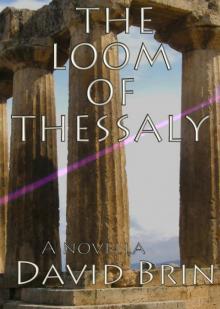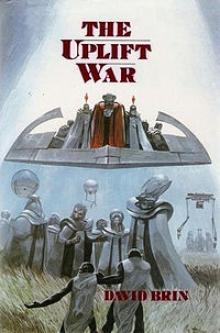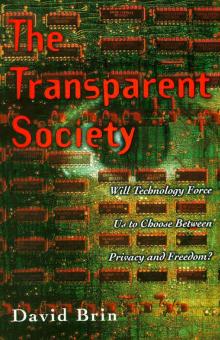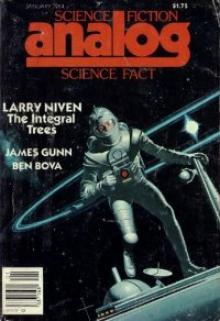- Home
- David Brin
The Crystal Spheres Page 2
The Crystal Spheres Read online
Page 2
4
Back in the days before starships—before Seeker broke Sol’s eggshell and precipitated the two-century CometWar —mankind had awakened to a quandary that caused the thinkers of those early days many sleepless nights.
As telescopes improved, as biologists began to understand, and even tailormake life, more and more people began to look up at the sky and ask, “Where the hell is everybody?”
The great lunar-based cameras tracked planets around nearby yellow suns. There were telltale traces of life even in those faint twenty-first-century spectra. Philosophers case nervous calculations to show that the galaxies must teem with living worlds.
And as they prepared our first starships, the deepthinkers began to wonder. If travel between the stars was as easy as it appeared to be, why hadn’t the fertile stars already been settled by somebody else?
After all, we were getting ready to head out and colonize. By even modest estimates of expansion rates, we seemed sure to fill the entire galaxy with human settlements within a few million years.
So why hadn’t this already happened? Why was there no sign of traffic among the stars? Why had the predicted galactic radio network of communications never been detected?
Even more puzzling… why was there absolutely no evidence that Earth had ever been colonized in the past? We were by then quite certain that our world had never hosted visitors from other worlds.
For one thing, there was the history of the Precambrian to consider.
Before the age of reptiles, before fish or trilobites or even amoebae, there was, on Earth, a two-billion-year epoch in which the only lifeforms were crude single-celled organisms without nuclei—the prokaryotes—struggling slowly to invent the basic structure of life.
No alien colonists ever came to Earth during all that time. We knew that for certain, for if they had, the very garbage they buried would have changed the history of life on our planet. A single leaky latrine would have filled the oceans with superior lifeforms that would have overwhelmed our crude little ancestors.
Two billion years without being colonized… and then the silent emptiness of the radioways… the philosophers of the twenty-first century called it the Great Silence. They hoped the starships would find the answer.
Then the very first ship, Seeker, somehow smashed the crystal-sphere we hadn’t even known existed, and inadvertently explained the mystery for us.
During the ensuing CometWar, we had little time for philosophical musings. I was born into that battle, and spent my first hundred years in harsh screaming littleships, blasting and herding iceballs that, left alone, would have fallen upon and crushed our fragile worlds.
We might have let Earth fall then. After all, more than half of humanity at that time lived in space colonies, which could be protected more easily than any sittingduck planet.
That might have been logical. But mankind went a little crazy when Earthmother was threatened. Belters herded cities of millions into the paths of hurling iceballs, just to save a heavy world they had only known from books and a faint blue twinkle in the blackness. The psychists took a long time to understand why. At the time it seemed like some sort of divine madness.
Finally the war was won. The comets were tamed and we started looking outward again. New starships were built, better than before.
I had to wait for a berth on the twelfth ship, and the wait saved my life.
The first seven ships were lost. As they beamed back their jubilant reports, spiraling closer to the beautiful green worlds they had found, they plowed into unseen crystalspheres and were destroyed.
And, unlike Seeker, they did not accomplish anything by dying. The crystalspheres remained after the ships had been icecrushed into comets.
We had all had such hopes… though those who remembered Seeker had worried quietly. Humanity seemed about to breathe free, at last! We were going to spread our eggs to other baskets, and be safe for the first time. No more would we fear overpopulation, crowding, or stagnation.
And all at once the hopes were smashed—dashed against those unseen, deadly spheres.
It took centuries even to learn how to detect the deadzones! How, we asked. How could the universe be so perverse? Was it all some great practical joke? What were these monstrous barriers that defied all the physics we knew, and kept us away from the beautiful littleworlds we so desired?
For three centuries, humanity went a little crazy.
I missed the worst years of the greatdepression. I was with a group trying to study the sphere around Tau Ceti. By the time I got back, some degree of order had been restored.
But I returned to a solar system that had clearly lost a piece of its heart. It was a long time before I heard true laughter again, on Earth or on her smallbodies.
I too went to bed and pulled the covers over my head for a couple of hundred years.
5
The entire crew breathed a reliefsigh when Captain Bok ordered me to put the safeties back on. I finally let go of my deadman switch and got up. The tension seeped away into a chain of shivers, and Alice had to hold me until I could stand again on my own.
Moishe had ordered us off alert because the goodsun’s system was empty.
To be accurate, the system teemed with life, but none of it was intelligent.
The greater asteroids held marvelous, self-sustaining ecosystems, absorbing sunlight under great windows. Twenty moons sheltered huge forests beneath tremendous domes. But there was no traffic, no radio or light messages. Yen’s detectors revealed no machine activity, nor the thought-touch of analytical beings.
It felt eerie to poke our way through those civilized lanes in the smallbody ways. For so long we had only performed such maneuvers in the well-known spaces of Solsystem.
During those first centuries after the crystal crisis, some men and women still thought it would be possible to live among the stars. Belters mostly, they claimed aloud that planets were nasty, heavy places anyway. So who needed them?
They went out to the badstars—red giants and tiny red dwarves, tight binaries and unstable suns. The badstars were protected by no crystalspheres. The would-be colonists found drifting clots of matter near the suns, and set up smallbody cities as they had at home.
Every one of the attempts failed within a few generations. The colonists simply lost interest in procreation.
The psychists finally decided the cause was related to the divine madness that had enabled us to win the CometWar.
Simply put, men and women could live on asteroids, but they needed to know that there was as blue world nearby—to see it in their sky. It’s a flaw in our character, no doubt, but we cannot go out and live in space all alone.
We have to have waterworlds, if the universe is ever to be ours.
This system’s waterworld we named Quest, after the beast so long sought by King Pelenor, our ship’s namesake. It shone blue and brown, under a clean whiteswaddling of clouds. For hours we circled above it, and simply cried.
Alice awakened ten corpsicles—prominent scientists who, the Worldcomps had promised, would not fall apart on the reawakening of hope.
We watched them take their turn at the viewport, joytears streaming down their faces, and we joined them to weep freely once again.
6
Pelenor was hardly up to the task of exploring this system by herself. We spent a year recovering and modifying several of the ancient ships we found drifting over our planet, so that teams could spread out, investigating every farcorner of this system.
By our second anniversary, a hundred biologists were quickscampering over the surface of Quest. They genescanned the local flora and fauna excitedly, and already were modifying Earthplants to fit into the ecosystem without causing imbalance. Soon they would start on animals from our genetanks.
Engineers exploring the smallbodies excitedly declared that they could get the lifemachines left behind by the prior race to work. There was room for a billion colonists out there, straight from the start.
/> But the archaeologists were the ones whose report we awaited most anxiously. Between my ferrying runs, they were the ones I helped. I joined them in the dusty ruins of Oldcity, at the edge of Longvalley, putting together piles of artifacts to be catalogued and slowly analyzed.
We learned that the inhabitants had called themselves the Nataral. They were about as similar to us as we might have expected—bipedal, ninefingered, weirdlooking.
Still, one got used to their faces after staring at their statues and pictures long enough. I even began to perceive subtle facial cues, and delicate, sensitive nuances of expression. When the language was cracked, we learned their race name and some of their story.
Unlike the few other alien intelligences we had observed from afar, the Natarals were individuals, and explorers. They too had spread into their planetary system after a worldbound history fully as colorful and goodbad as our own.
Like us, they had two conflicting dreams. They longed for the stars, for room to grow. And they also wished for other faces, for neighbors.
By the time they built a starship—their first—they had given up on the idea of neighbors. There was no sign anybody had ever visited their world. They heard nothing but silence from the stars.
Still, when they were ready, they launched their firstship toward their other dream—Room.
And within weeks of the launching, their sun’s crystalsphere shattered.
For two weeks we double-checked the translations. We triple-checked.
For millennia we had been searching for a way to destroy these deadly barriers around goodstars… trying to duplicate on purpose what Seeker had accomplished by accident. And now we had the answer.
The Nataral, like us, had managed to destroy one and only one crystalsphere. Their own. And the pattern was exactly the same, down to the CometWar that subsequently almost wrecked their high civilization.
The conclusion was obvious. The deathbarriers were destructible, but only from the inside!
And just when that idea was starting to sink in, the archaeologists dug up the Obelisk.
7
Our top linguist, Garcia Cardenas, had a flair for the dramatic. When Alice and I visited him in his encampment at the base of the newly excavated monument, he insisted on putting off all discussion of his discovery until the next day. He and his partner instead prepared a special meal for us, and raised their glasses to toast Alice.
She stood and accepted their accolades with dry wit, and then sat down to continue nursing our baby.
Old habits break hard, and only a few of the women had managed yet to break centuries of biofeedback conditioning not to breed. Alice was among the first to reactivate her ovaries and bring a child to our new world.
It wasn’t that I was jealous. After all, I basked in the only slightly lesser glory of fatherhood. But I was getting impatient with all of this ballyhoo. Except for Moishe Bok, I was perhaps the oldest human here—old enough to remember when people had children as a matter of course, and therefore made time for other matters, when something important was up!
Finally, when the celebration had wound down, Garcia Cardenas nodded to me, and led me out the back flap of the tent. We followed a dim path down a sloping trail to the digs, by the light of the ring of bright smallbodies the Nataral had left permanently in place over the equatorial sky of Quest.
We finally arrived at a bright alloy wall that towered high above our heads. It was made of a material our techs had barely begun to analyze, and was nearly impervious to the effects of time. On it were inscribed hardpatterns bearing the tale of the last days of the Nataral.
A lot of that story we knew from other translated records. But the end itself was still a mystery, and no small cause of nervousness. Had it been some terrible plague? Did the intelligent machines, on which both their civilization and ours relied, rebel and slaughter their masters? Did their sophisticated bioengineering technology get out of their control?
What we did know was that the Nataral had suffered. Like humans, they had gone out and found the universe closed to them. Both of their great dreams—of goodplaces to spreadsettle, and of other minds to meet—had been shattered like the deathsphere around their own star. Like humans, they spent quite a long time not entirely sane.
In the darkness deep within the dig, Cardenas had promised I would find answers.
As he prepared his instruments I listened to the sounds of the surrounding forestjungle. Life abounded on this world. There were lovely, complicated creatures, some clearly natural, and some just as clearly the result of clever biosculpting. In their creatures, in their art and architecture, in the very reasons they had almost despaired, I felt a powerful closeness to the Nataral. I would have liked them, I imagined.
I was glad to take this world for humanity, for it might mean salvation for my species. Still, I regretted that the other race was gone.
Cardenas motioned me over to a holistank he had set up at the base of the Obelisk. As we put our hands into the blackness, a light appeared on the face of the monolith. Where the light traveled, we would touch, and feel the passion of those final days of the Nataral.
I stroked the finetuned, softresonant surface. Cardenas led me, and I felt the Endingtime as the Nataral meant it to be felt.
Like us, the Nataral had passed through a long period of bitterness, even longer than we had endured until now. To them, indeed, it seemed as if the universe was a great, sick joke.
Life was found everywhere among the stars. But intelligence arose only slowly and rarely, with many false starts. Where it did occur, it was often in a form that did not happen to covet space or other planets.
But if the crystalspheres had not existed, the rare sites where starfaring developed would spread outward. Species like us would expand, and eventually make contact with one another, instead of searching forever among sandgrains. An elder race might arrive where another was just getting started, and help it over some of its crises.
If the crystalspheres had not existed…
But that was not to be. Starfarers could not spread, because crystalspheres could only be broken from the inside! What a cruel universe it was!
Or so the Nataral had thought.
But they persevered. And after ages spent hunting for the miraculous goodstar, their farprobes found five water-worlds unprotected by deathbarriers.
My touchhand trembled as I stroked the coordinates of these accessible planets. My throat caught at the magnitude of the gift that had been given us on this obelisk. No wonder Cardenas had made me wait! I, too, would linger when I showed it to Alice.
But then, I wondered, where had the Nataral gone? And why? With six worlds, surely their morale would have lifted!
There was a confusing place on the Obelisk… talk of black holes and of time. I touched the spot again and again, while Cardenas watched my reaction. Finally, I understood.
“Great Egg!” I cried. The revelation of what had happened made the discovery of the five goodworlds pale into insignificance.
“Is that what the crystalspheres are for?”
I couldn’t believe it.
Cardenas smiled. “Watch out for teleology, Joshua. It is true that the barriers would seem to show the hand of the creator at work. But it might be simply circumstance, rather than some grand design.
“All that we do know is this. Without the crystalspheres, we ourselves would not exist. Intelligence would be more rare than it already is. And the stars would be almost barren of life.
“We have cursed the crystalspheres for ten thousand years,” Cardenas sighed. “The Nataral did so for far longer—until they at last understood.”
8
If the crystalspheres had not existed…
I thought about it that night, as I stared up at the shimmering, pale light from the drifting Shards, through which the brighter stars still shone.
If the crystalspheres had not existed, then there would come to each galaxy a first race of star-treaders. Even if most intelligence
s were stay-at-homes, the coming of an aggressive, colonizing species was inevitable, sooner or later.
If the crystalspheres had not existed, the first such star-treaders would have gone out and taken all the worlds they found. They would have settled all the waterworlds, and civilized the smallbodies around every single goodstar.
Two centuries before we discovered our crystalsphere, we humans had already started wondering why this had never happened to Earth. Why, during the three billion years that Earth was “choice real estate,” had no race like us come along and colonized it?
We found out it was because of the deathbarrier surrounding Sol, which kept our crude little ancestors safe from interference from the outside… which let our nursery world nurture us in peace and isolation.
If the crystalspheres had not been, then the first star-treaders would have filled the galaxy, perhaps the universe. It is what we would have done, had the barriers not been there. The histories of those worlds would be forever changed. And there is no way to imagine the death-of-possibility that would have resulted.
So, the barriers protected worlds until they developed life capable of cracking the shells from within.
But what was the point? What benefit was there in protecting some young thing, only for it to grow up into bitter, cramped loneliness in adulthood?
Imagine what it must have been like for the very first race of star-treaders. Never, were they patient as Job, would they find another goodstar to possess. Not until the next egg cracked would they have neighbors to talk to.
No doubt they despaired long before that.
Now we, humanity, had been gifted of six beautiful worlds. And if we could not meet the Nataral, we could, at least, read their books and come to know them. And from their careful records we could learn about the still earlier races which had emerged from each of the other five goodworlds, each into a lonely universe.

 The Practice Effect
The Practice Effect Infinity's Shore
Infinity's Shore Insistence of Vision
Insistence of Vision Sundiver
Sundiver Brightness Reef
Brightness Reef Existence
Existence The Transparent Society
The Transparent Society Startide Rising
Startide Rising The Postman
The Postman The Uplift War
The Uplift War The Loom of Thessaly
The Loom of Thessaly Otherness
Otherness Sundiver u-1
Sundiver u-1 The Uplift War u-3
The Uplift War u-3 Infinity's Shore u-5
Infinity's Shore u-5 Brightness Reef u-4
Brightness Reef u-4 Uplift 2 - Startide Rising
Uplift 2 - Startide Rising Kiln People
Kiln People Heaven's Reach u-6
Heaven's Reach u-6 The Transparent Society: Will Technology Force Us to Choose Between Privacy and Freedom?
The Transparent Society: Will Technology Force Us to Choose Between Privacy and Freedom? Star Wars on Trial
Star Wars on Trial Lungfish
Lungfish Tank Farm Dynamo
Tank Farm Dynamo Just a Hint
Just a Hint A Stage of Memory
A Stage of Memory Foundation’s Triumph sf-3
Foundation’s Triumph sf-3 Thor Meets Captain America
Thor Meets Captain America Senses Three and Six
Senses Three and Six The River of Time
The River of Time Chasing Shadows: Visions of Our Coming Transparent World
Chasing Shadows: Visions of Our Coming Transparent World Foundation's Triumph
Foundation's Triumph Startide Rising u-2
Startide Rising u-2 The Fourth Vocation of George Gustaf
The Fourth Vocation of George Gustaf The Heart of the Comet
The Heart of the Comet The Crystal Spheres
The Crystal Spheres